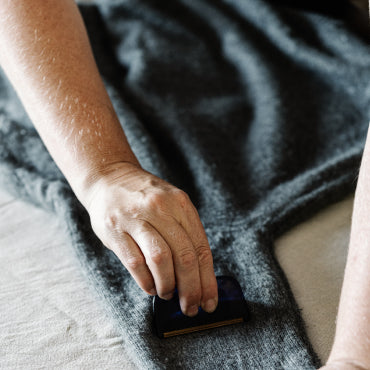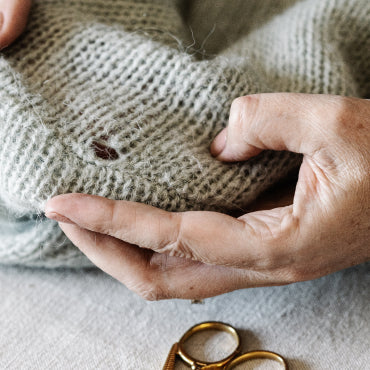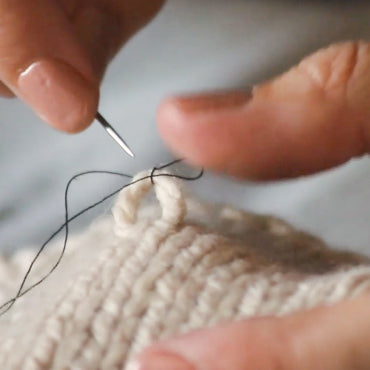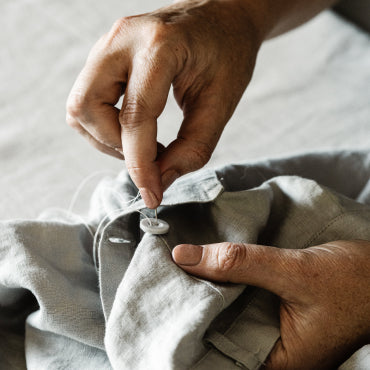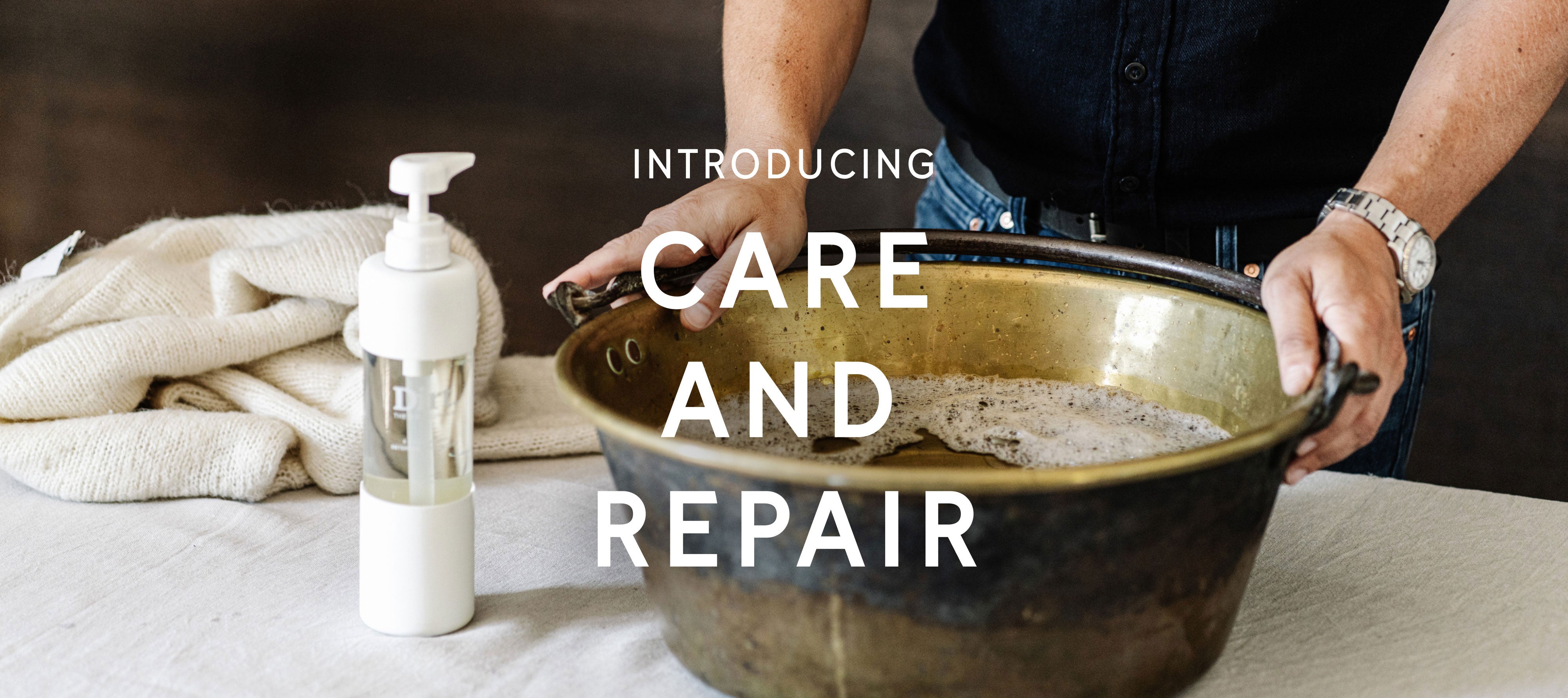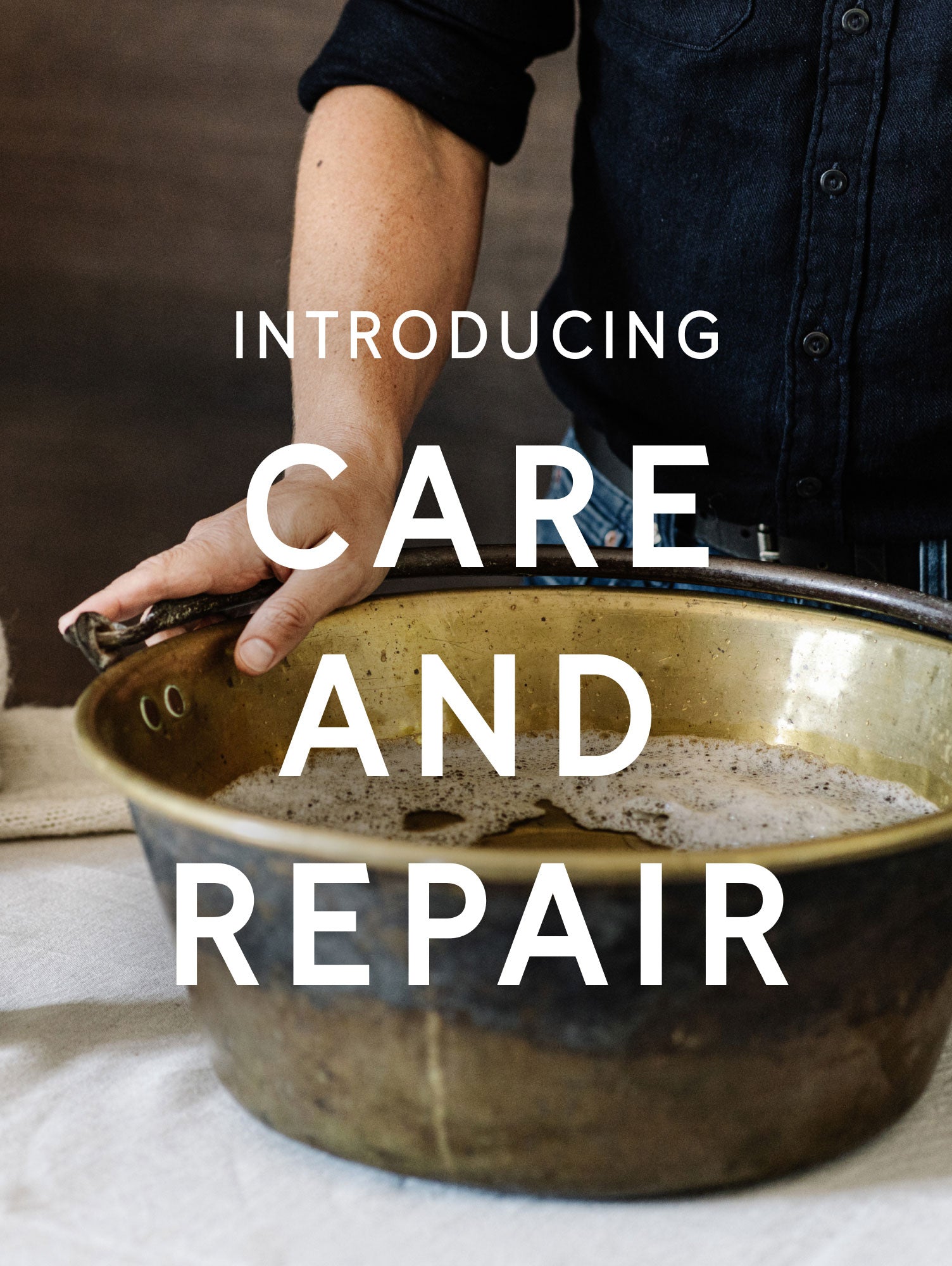CARE & REPAIR TO REDUCE ENVIRONMENTAL IMPACT
GENERAL GARMENT CARE
Does it pass the sniff test? Only wash your clothes when needed – spot clean or air garments to extend the number of wears between washes.
Wait until you have a full load before using your washing machine – it takes as much energy to run a half load as it does to run a full load.
Only use cold water to wash. It is just as effective at cleaning and reduces energy consumption.
Microplastics are released when washing fabrics containing synthetics. Install a microplastic filter on your machine or place garments in bags specially designed to catch microplastics.
Choose an environmentally responsible laundry detergent that is plant based, biodegradable, and low in sodium and phosphate. Never use bleach and look for natural options to shift stains.
Use old containers to refill detergents at your local bulk store if available or choose companies who offer refills.
Avoid using a dryer. Gently pull your garment back into shape if necessary and air dry, either flat or hanging, in the shade. Air drying is gentler on your clothes and it uses no energy.
Hanging your garments as soon as they are washed reduces creasing. Hang garments in the bathroom while showering to help smooth out creases.
Dry cleaning uses harsh chemicals to clean your clothes. Avoid dry cleaning or if totally necessary, choose an accredited Green Dry Cleaner.
For care advice specific to your garment, always refer to the care label or the care recommendations listed on the product page for your garment.
DENIM CARE
Denim will soften and fade with wear and washing. To extend the life of your denim garments and reduce environmental impact, ensure you purchase the correct fit and only wash as needed. You should get at least ten wears between washes, often more!
Spot cleaning with a damp rag and regularly airing on the line will reduce the need to wash. When your denim does need washing, turn your garment inside-out and machine wash in cold water using gentle detergents. Avoid clothes dryers as they damage fibres and speed up the aging process. Simply air dry in the shade.
There is no need to iron jeans. Any creases will disappear within an hour of wearing.
KNITWEAR CARE
We want to ensure your knitwear garment looks as good as possible for as long as possible and looking after it properly is the key
SUSTAINABLE CARE: Knitwear yarn is created by twisting fibres together. This process, as well as normal wear, will naturally cause fibres to break and knot together resulting in pilling or fuzz. Using a pilling comb combined with following the care instructions, will extend the life of your knitted garments.
WASHING & AIRING: Consider airing your knitwear garment whenever possible, rather than washing it. When washing is required, gently hand wash your garment inside out, in cold water, with a mild wool detergent. Squeeze out excess water. Do not wring or spin dry. Carefully pull your garment back into shape and dry flat in the shade.
Avoid washing unless necessary. Do not wash in a machine even on hand wash or delicate cycles.
Knitwear can shrink up to 3cm in length and width however after pressing and wear, the yarn will relax and grow, all of which our production team consider for each design.
STORAGE: To avoid stretching, gently fold and store flat in drawers or on a shelf. Do not hang.
VISCOSE CARE
The construction of all viscose fabrics results in unique properties that perform differently from other fabrics and require specific care. We recommend cold hand washing in a mild detergent. Only wash when required to reduce water consumption. Do not soak, rub, wring or spin. Gently pull the garment back into shape and air dry, either flat or hanging, in the shade. After washing, viscose will appear to have shrunk and will have a coarse hand feel. Don’t worry! Once it is dry, use a warm steam iron on the reverse. The fabric will iron out easily and regain its shape, hand feel and fluidity. On the first wash, there may be a small variance in measurements.
LEATHER CARE
Leather will age and soften with wear. Our leather products have been treated with a protective coating to help resist stains. Over time with use, these coatings may break down. As needed, use a leather conditioner or spray to protect your leather, ensuring you test them first in a hidden spot. The colour may transfer, take care of light-coloured items such as clothing and furniture.
APPROPRIATE USE: Leather will stretch over time. Ensure you do not carry more than intended. Smaller and softer style bags are not designed to carry heavy or bulky loads, and store only one card per pocket in wallets.
SPECIALTY LEATHERS: Leathers with specialty finishes including recycled, metallic, printed and patent leathers, require extra care. The finish cannot be reapplied once scratched or worn. To keep your piece looking good avoid contact with abrasive surfaces and liquids that contain solvents or alcohol. Wipe clean with a soft cloth as needed. Do not use a brush or rough cloth as this may scratch the leather finish.
NON-LEATHER BAG CARE
APPROPRIATE USE: Ensure you do not carry more than intended to avoid excessive strain on your bag. Smaller and softer style bags are not designed to carry heavy or bulky loads.
PU SYNTHETIC LEATHER: Wipe clean with a soft damp cloth as needed. Do not use a brush or rough cloth as this may damage the surface. Avoid contact with abrasive surfaces and liquids that contain solvents or alcohol. Avoid prolonged periods of direct sunlight. The colour may transfer, take care of light-coloured items such as clothing and furniture.
FABRIC (POLYESTER/COTTON): Spot clean if required with a soft damp cloth. Do not use a brush or rough cloth as this may damage the surface. Do not machine wash. Avoid contact with abrasive surfaces and liquids that contain solvents or alcohol. For added protection, spray with a good quality waterproof spray.
FOOTWEAR CARE
LEATHER FOOTWEAR: Regularly condition with a neutral colour cream conditioner. Apply with a soft cloth and rub very gently over the surface. Do not use a brush or rough cloth as it may damage the finish. Avoid water and alcohol-based cleaners. For added protection, spray with a good quality waterproof spray.
SPECIALTY LEATHER FOOTWEAR: Leathers with specialty finishes including metallic, printed, hair-on, and patent leathers, require extra care. Finishes on leather cannot be reapplied once scratched or worn. This is not a flaw and is considered normal wear. Avoid abrasive surfaces and liquids that contain solvents or alcohol. Wipe clean with a soft cloth as needed. Do not clean with a brush or rough cloth as this may scratch the surface.
FABRIC FOOTWEAR: Avoid abrasive surfaces and liquids that contain solvents or alcohol. Excessive contact with dirt or liquid will stain the fabric. Where possible, avoid getting your shoes soaked or wet for extended periods. Wipe clean with a soft cloth as needed. Do not clean with a brush or rough cloth as this may damage the fabric.
SOLE CARE: Our soles are made from high quality rubber or resin. Where possible, avoid getting your shoes soaked or wet for extended periods. Wipe clean with a soft cloth as needed. Do not clean with a brush or rough cloth as this may damage the surface.
JEWELLERY CARE
TIMBER: Timber items may discolour or wear from contact with beauty products and liquids. Do not wear in water. Avoid rough surfaces. The surface finish cannot be repaired once damaged. Colours may fade if stored in direct sunlight. If milky spots or marks appear due to light contact with liquid, polish with a natural jewellery wax.
METAL: Avoid contact with liquids, including beauty products. Avoid contact with abrasive surfaces, the surface finish cannot be repaired once damaged.
SPECIALTY METAL FINISHES: The surface on metals with a specialty finish including rubberised, enamelled and plated metals, cannot be repaired once damaged. Avoid contact with liquids, including beauty products, and abrasive surfaces. Colours may fade if stored in direct sunlight.
GLASS: Wipe clean with a soft cloth as needed. Do not clean with a brush or rough cloth as this may damage the surface.
LEATHER: Avoid contact with liquids, including beauty products.
RESIN: Wipe clean with a soft dry cloth or clean in cold water if needed. The surface can scratch if exposed to abrasive surfaces and lighter colours can be affected by sunscreens, make up or other liquids, particularly if tinted. For best care we suggest wiping your piece down after wear.
REPAIR & CARE VIDEO GUIDES
